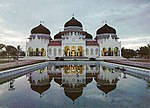Portal:Indonesia/AOTW/35, 2007
The spread of Islam in Indonesian is thought to have begun sometime during the eleventh century, although Muslims had visited Indonesia early in the Muslim era. Through assimilation Islam had supplanted Hinduism and Buddhism as the dominant religion of Java and Sumatra by the end of the 16th century. At this time, only Bali retained a Hindu majority and the outer islands remained largely animist but would adopt Islam and Christianity in seventeenth and eighteenth centuries.
The spread of Islam was driven by increasing trade links outside of the archipelago; in general, traders and the royalty of major kingdoms were the first to adopt the new religion. By the end of the thirteenth century, Islam had been established in North Sumatra; by the fourteenth in northeast Malaya, Brunei, the southern Philippines and among some courtiers of East Java; and the fifteenth in Malacca and other areas of the Malay Peninsula. Although it is known that the spread of Islam began in the west of the archipelago, the fragmentary evidence does not suggest a rolling wave of conversion through adjacent areas; rather, it suggests the process was complicated and slow.
Despite being one of the most significant developments in Indonesian history, historical evidence is fragmentary and generally uninformative such that understandings of the coming of Islam to Indonesia are limited; there is considerable debate amongst scholars about what conclusions can be drawn about the conversion of Indonesian peoples. Available evidence cannot explain more complicated matters such as how lifestyles were affected by the new religion or how deeply it affected societies. It cannot be assumed, for example, that because a ruler was known to be a Muslim, that the process of Islamisation of that area was complete; rather the process was, and remains to this day, a continuous process in Indonesia. (Read More...)

